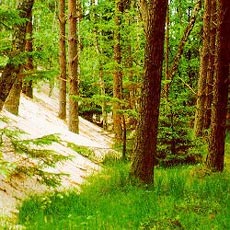|
|
|
|
Top Poland Destinations:
Krakow hotels Warsaw hotels Warszawa hotels Wroclaw hotels Gdansk hotels See more hotels in Poland
World Destinations:
 Guides » Poland » Slowinski National Park Guides » Poland » Slowinski National ParkSlowinski National Park
While in Poland, you should take time out of your schedule to visit the Slowinski National Park. First established in 1967, this park was originally planned in 1945 after World War II. The part is quite large, measuring more than 18,000 hectares. Of this, close to 60% is covered in water, 25% is forest area, approximately5% is dunes and beautiful beaches, 8% consists of moors and swampland, and finally, 8% is comprised of pastures and meadows.
Slowinski National Park gets its name from Slowincy – Slav, an old ethnic group of people who had lived in this are of Poland for years. While the park offers a number of attractions, probably one of the most impressive is the skansen in Kluki, presenting their culture and pride. Because of the park’s natural beauty and diversity, each year around 800,000 people visit from around the globe.  Probably one of the most spectacular areas of the park is the Baltic coast to the south. There, you will discover Europe’s largest sand dunes. Today, the landscape, plant coverage, fauna, peat, and forest areas are strictly protected by reserves, covering an area of 6,650 hectares. Because of the tremendous value the Slowinski National Park offers, it has now been registered on the World List of Biosphere Reserves. Probably one of the most spectacular areas of the park is the Baltic coast to the south. There, you will discover Europe’s largest sand dunes. Today, the landscape, plant coverage, fauna, peat, and forest areas are strictly protected by reserves, covering an area of 6,650 hectares. Because of the tremendous value the Slowinski National Park offers, it has now been registered on the World List of Biosphere Reserves.
The primary features of this national park include the pristine beaches, sand dunes, and coastal lakes. One dune in particular, the Czolpinko dune, is now completely overgrown with massive pine forest. While beautiful, the other dunes to include the Lesna dune, Lacka dune, Stilo dune, and Gory Wschodnie dune are just as unique, each of varying heights. The key when visiting the Slowinski National Park is to see all you can because the areas are all so original and distinct. Next, there are the incredible coastal lakes. These include the Gardno, the Dolgie Wielkie, the Dolgie Male, and the Lebsko. Combined, the lakes consume 50% of the park. The two larger lakes, which include the Lebsko and the Gardno, are separated from the Baltic Sea by small, sandy strips of land. In the beginning, these two coastal lakes were actually small and shallow reservoirs that were surrounded by sedges and reeds. With this, you would have found a number of water birds taking full advantage of the shelter. Keep in mind that the coastal lakes in the Slowinski National Park are also strict reserves to help preserve their magnificence of life and plant form. Throughout the area are moors, swamps, meadows, and heaths, primarily when you head to the southern shores. The way the water flow works is that the Leba River flows into the Lebsko Lake. Then, the Lupawa River flows into the Gardno Lake. These dunes are actually made from Holocene deposits with the majority being overgrown with trees and plants. Because of the color, they are known as “gray dunes”. Again, some of the smaller dunes do not have the foliage since the soil-forming processes are quite slow. For the dunes that are overgrown with pine forest, they have well-shaped podsolic soils. In addition, under the thickest cover of the dune sand are fossil relict soils, remnants of earlier forests. As you visit the Slowinski National Park, keep in mind that the winter and summer months are very mild. However, expect to find high levels of humidity, which can make it feel much hotter and stickier. Just remember that because you are near the sea, temperatures can fluctuate, and sometimes, without much warning. Regardless of the time of year you visit, you will fall in love with this part of Poland. Truly magnificent, the Slowinski National Park is worth the time to experience. Last Updated: 10/19/2006 3:14:00 PM Mode articles for Poland Poland is a beautiful country with incredible architecture, lots of vibrant flowers, delicious food, warm people, and a country that has had to shake off a difficult past to reinvent itself. Located in the heart of
Poland is a beautiful country with incredible architecture, lots of vibrant flowers, delicious food, warm people, and a country that has had to shake off a difficult past to reinvent itself. Located in the heart of ... continue >>  Located in the northern region of Poland on the Vistula River is a state called Torun. Today, some 200,000 people live there. Within this state is a capital city called the Kuyavian-Pomeranian Voivodship. Prior to 1999,
Located in the northern region of Poland on the Vistula River is a state called Torun. Today, some 200,000 people live there. Within this state is a capital city called the Kuyavian-Pomeranian Voivodship. Prior to 1999,... continue >>  Warsaw was not founded until the early 14th century and has been the capital city on and off since 1611. Warsaw has long been a center for culture and industry. In addition, prior to the devastation caused by World War
Warsaw was not founded until the early 14th century and has been the capital city on and off since 1611. Warsaw has long been a center for culture and industry. In addition, prior to the devastation caused by World War ... continue >> |
|
| | |
|
©2025 HotelsRu.com About us Privacy Site map The Joys of Visiting Poland |
|
 Look for deals on hotels?
Look for deals on hotels?